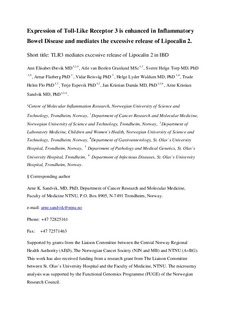| dc.contributor.author | Østvik, Ann Elisabet | |
| dc.contributor.author | Granlund, Atle Van Beelen | |
| dc.contributor.author | Torp, Sverre Helge | |
| dc.contributor.author | Flatberg, Arnar | |
| dc.contributor.author | Beisvag, Vidar | |
| dc.contributor.author | Waldum, Helge | |
| dc.contributor.author | Flo, Trude Helen | |
| dc.contributor.author | Espevik, Terje | |
| dc.contributor.author | Damås, Jan Kristian | |
| dc.contributor.author | Sandvik, Arne Kristian | |
| dc.date.accessioned | 2017-11-06T11:03:40Z | |
| dc.date.available | 2017-11-06T11:03:40Z | |
| dc.date.created | 2013-09-26T14:17:36Z | |
| dc.date.issued | 2013 | |
| dc.identifier.citation | Clinical and Experimental Immunology. 2013, 173 (3), 502-511. | nb_NO |
| dc.identifier.issn | 0009-9104 | |
| dc.identifier.uri | http://hdl.handle.net/11250/2464187 | |
| dc.description.abstract | Anti-microbial peptides might influence the pathogenesis and course of inflammatory bowel disease (IBD). We sought to clarify the role of the anti-microbial glycoprotein lipocalin 2 (LCN2) in the colon by determining its localization and regulation in IBD. Following a microarray gene expression study of colonic biopsies from a large IBD population (n = 133), LCN2 was localized using immunohistochemistry and in-situ hybridization. Moreover, we examined the regulation of LCN2 in HT-29 cells with a panel of pattern recognition receptors (PRRs) and sought evidence by immunohistochemistry that the most relevant PRR, the Toll-like receptor (TLR)-3, was indeed expressed in colonic epithelium in IBD. LCN2 was among the 10 most up-regulated genes in both active ulcerative colitis (UCa) and active Crohn's disease (CDa) versus healthy controls. LCN2 protein was found in both epithelial cells and infiltrating neutrophils, while mRNA synthesis was located solely to epithelial cells, indicating that de-novo synthesis and thus regulation of LCN2 as measured in the gene expression analysis takes place in the mucosal epithelial cells. LCN2 is a putative biomarker in faeces for intestinal inflammation, different from calprotectin due to its epithelial site of synthesis. LCN2 release from the colonic epithelial cell line HT-29 was enhanced by both interleukin (IL)-1β and the TLR-3 ligand poly(I:C), and TLR-3 was shown to be expressed constitutively in colonic epithelial cells and markedly increased during inflammation. | nb_NO |
| dc.language.iso | eng | nb_NO |
| dc.publisher | Wiley | nb_NO |
| dc.title | Expression of Toll-like receptor-3 is enhanced in active inflammatory bowel disease and mediates the excessive release of lipocalin 2 | nb_NO |
| dc.type | Journal article | nb_NO |
| dc.type | Peer reviewed | nb_NO |
| dc.description.version | acceptedVersion | nb_NO |
| dc.source.pagenumber | 502-511 | nb_NO |
| dc.source.volume | 173 | nb_NO |
| dc.source.journal | Clinical and Experimental Immunology | nb_NO |
| dc.source.issue | 3 | nb_NO |
| dc.identifier.doi | 10.1111/cei.12136 | |
| dc.identifier.cristin | 1052681 | |
| dc.relation.project | Norges forskningsråd: 223255 | nb_NO |
| dc.description.localcode | This is the peer reviewed version of the following article: [Expression of Toll-like receptor-3 is enhanced in active inflammatory bowel disease and mediates the excessive release of lipocalin 2], which has been published in final form at [http://onlinelibrary.wiley.com/doi/10.1111/cei.12136/abstract]. This article may be used for non-commercial purposes in accordance with Wiley Terms and Conditions for Self-Archiving. | nb_NO |
| cristin.unitcode | 194,65,15,0 | |
| cristin.unitname | Institutt for klinisk og molekylær medisin | |
| cristin.ispublished | true | |
| cristin.fulltext | original | |
| cristin.fulltext | postprint | |
| cristin.qualitycode | 1 | |
